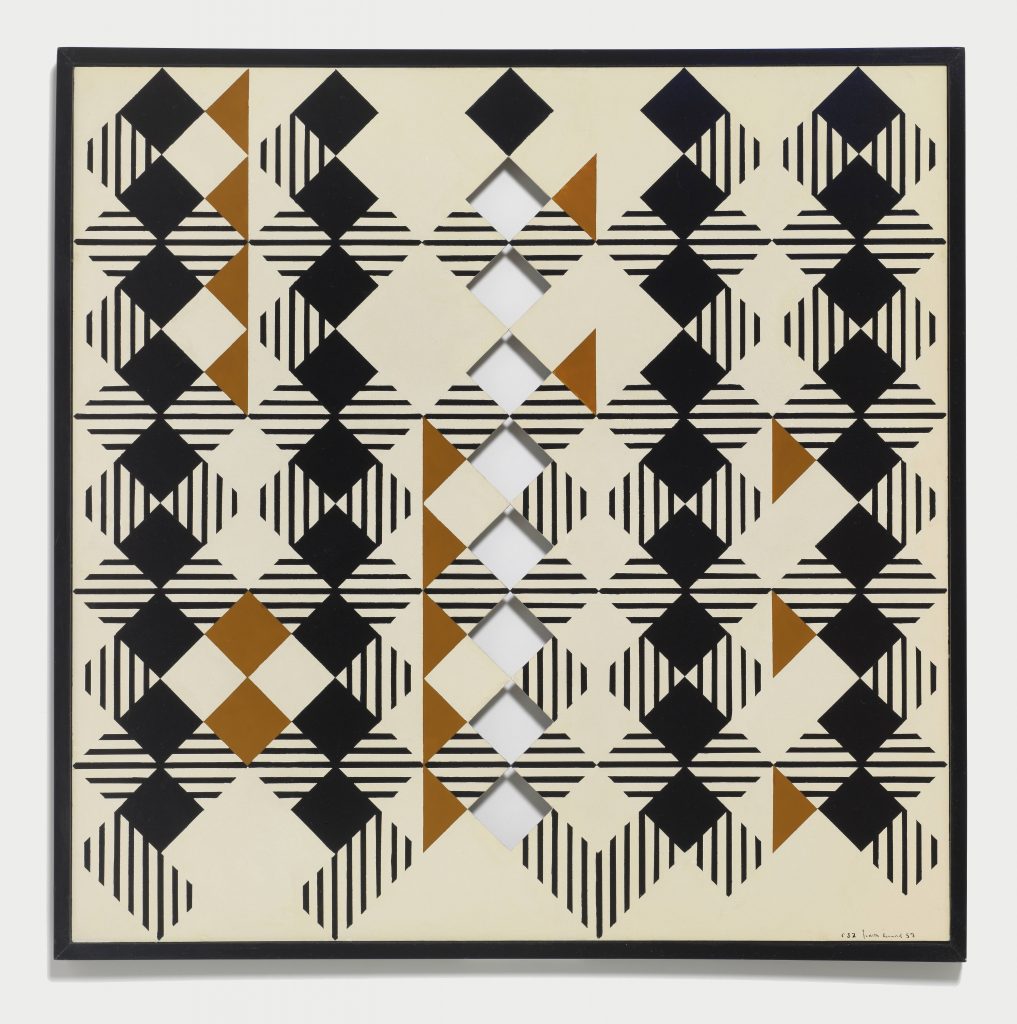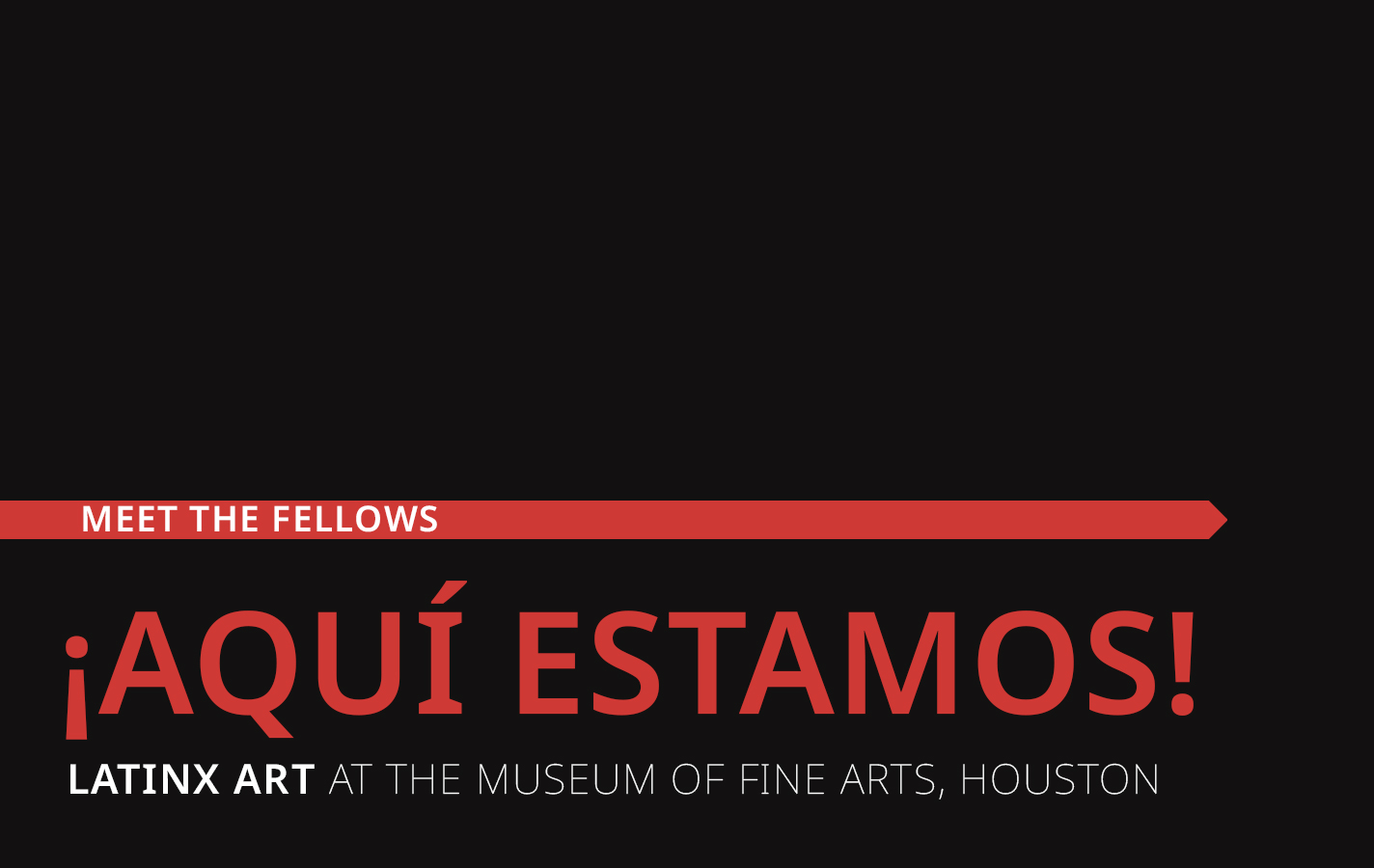May 15, 2024
The 2023-24 ICAA’s UH Object-based Learning Fellow, Elliot Penn (MA, Art History, 2024), models the object-based inquiry approach on one of his favorite objects in the collection: Judith Lauand’s Variação de quadrados (1957).
Brazilian artist Judith Lauand passed away on December 9, 2022 in São Paulo at the age of 100. Through her endeavors in artmaking, Lauand played a vital role in the emergence of a vibrant, modernist avant-garde in Brazil. She is best known today as the only female member of the grupo ruptura, a mid-century, São Paulo-based artist group dedicated to Concrete art.[1] However, while acclaimed as the “Dama do concretismo” today, Lauand’s art was not always well received by critics during her life.
Ferreira Gullar, the Rio de Janeiro-based poet and art critic, was unimpressed with Lauand’s paintings shown at the I Exposição Nacional de Arte Concreta at the Ministerio da Educação e da Saúde in Rio de Janeiro. This exhibition, which was first held in December 1956 at the Museu de Arte Moderna de São Paulo (MAM-SP), featured works by Alfredo Volpi, Lygia Clark, Waldemar Cordeiro, and Ivan Serpa. In his review of the show, published in the Jornal do Brasil: suplemento dominical, Gullar dismissively notes, “Judith Lauand presents five works, all of limited interest.” (Figure 1) In his article, Gullar presents a comparison between the Concrete artists of São Paulo and those of Rio de Janeiro. According to Gullar, the concretists of Rio de Janeiro preferred subjects that refer to materials and color, while São Paulo-based concretists prioritized movement.[2]

Ferreira Gullar, “I – O Grupo de São Paulo : I Exposição Nacional de Arte Concreta,” Jornal do Brasil : suplemento dominical (Rio de Janeiro, Brasil), February 17, 1957.
ICAA DA 1087166
By the mid-1950s, Lauand had established herself as an integral part of the Paulista faction of Concrete artists led by Waldemar Cordeiro. Lauand had resided in the Jardins district of São Paulo since December 1952.[3] Born in São Paulo, she returned to the city after completing her fine arts degree at the Escola de Belas Artes de Araraquara.[4] From December 1953 until February 1954, she served as a docent at the second São Paulo biennial. In preparation for the biennial, Lauand was trained extensively under Wolfgang Pfeiffer, technical director of the Museu de Arte Moderna de São Paulo.[5] She attended art history seminars, public speaking classes, and workshops with visiting artists. In 1955, Cordeiro invited her to join the grupo ruptura, an artist group he co-founded in 1952.[6] The grupo ruptura repudiated figurative art and symbolic expression. Members of the grupo ruptura aimed to create art based on the objectively verified principles grounded in Gestalt theory and mathematics.[7]
In 1957, the same year Gullar wrote his review, Lauand painted Variação de quadrados (Variation of Squares) (Figure 2). This enamel on hardboard painting is currently on view in Gallery 204 of the Nancy and Rich Kinder Building at the Museum of Fine Arts, Houston. In composition and in technique, Lauand’s Variação de quadrados closely adheres to the depersonalized, scientific, and industrial style espoused and practiced by Cordeiro. Furthermore, Variação de quadrados manifests the Gestalt theories concerning perspective and perception that are commonly associated with Concrete art. Glossy, mathematical, and geometric, Lauand’s Variação de quadrados is as the title suggests: a collection of squares of varied sizes, completeness, color, kind, and pattern. The composition itself, measuring 60.3 × 60.3 cm, is also square. Four vertical rows of black squares appear against a cream background. These black squares are stacked on their right angles. Interspersed between these four vertical rows are additional striped squares of the same size. These striped squares, which contain five horizontal or vertical black lines per block, balance atop each other. There are also two solid burnt orange squares and fourteen squares that are half orange and half beige. In the middle of the composition, where the eye expects more black squares, there is a vertical row of eight square cuts in the hardboard, through which the gallery wall is visible.

Judith Lauand (1922-2022)
Variação de quadrados (Variation of Squares), 1957
Enamel on hardboard, 23 3/4 × 23 3/4 in. (60.3 × 60.3 cm)
The Adolpho Leirner Collection of Brazilian Constructive Art, museum purchase funded by the Caroline Wiess Law Foundation
While Variação de quadrados is balanced and harmonious, it is also asymmetrical. With an energetic, rhythmic pattern, the composition creates a sense of order and consistency, but this is disrupted by stray squares of color, intentionally placed reminders of disharmony. Additionally, as one stares at the work, more shapes become recognizable. From the ground color, in conjunction with the surrounding-colored squares and square cuts, additional, larger cream squares become visible. Depending on where the eye falls, certain shapes, implicit or explicit, in the work appear to recede or emerge on the surface of the board. This specific combination of color and shape tricks the eye into perceiving depth. For example, to the right of the second and third square cuts from the top is a cream square, four times the size of the black squares. This large square seemingly sits in front of or on top of the surrounding cuts and squares. It appears as if this large square is closer to the viewer than the others. The eight square cuts in the center of the composition confirm that the work is in fact three dimensional. Variação de quadrados allows for, or perhaps encourages, multistable perception. At times, the color of the wall revealed by the square cuts acts as the ground. Other times, the cream colored shapes act as the ground. Perceptions of the artwork are constantly shifting due to the work’s illusory pattern. Through her use of repeated geometric shapes and color, Lauand invites the mind of the viewer to make groupings and find similarities.
Lauand once remarked, “A painting is not explained. A painting is seen. Words are not substitutes for the direct vision of formal structure, of color relationships, of spaces, of plasticity… the organization of elements.”[8] The description and analysis found in this text are certainly not an adequate substitute for the visual experience of Lauand’s art. However, my goal in writing this blog post is not to explain Variação de quadrados. Rather, my goal, as Lauand suggests, is to see the work, to look again and again, to document my observations, and to provide the necessary context to better appreciate and engage with Variação de quadrados. Hopefully, when visiting the Kinder Building, you will stop by Gallery 204 in the Adolpho Leirner Collection to see this most visually and conceptually intriguing painting.
[1] Lauand was not a signatory of the “ruptura manifesto” (1952). The original members and signatories were Lothar Charoux, Waldemar Cordeiro, Geraldo de Barros, Kazmer Féjer, Leopoldo Haar, Luiz Sacilotto and Anatol Wladyslaw. See ICAA Digital Archive 771349.
[2] Heloísa Espada, Annotation for “I – O Grupo de São Paulo : I Exposição Nacional de Arte Concreta,” ICAA Digital Archive 1087166.
[3] Aliza Edelman, “Judith Lauand’s Sketchbooks and the Visualization of Concrete Form in 1954,” in Purity Is a Myth: The Materiality of Concrete Art from Argentina, Brazil, and Uruguay, ed. Zanna Gilbert et al. (Los Angeles, California: Getty Research Institute and Getty Conservation Institute, 2021), 91.
[4] Edelman, 92.
[5] Edelman, 92.
[6] Edelman, 91.
[7] Mari Carmen Ramírez and Corina E. Rogge, “Looking to the Past to Paint the Future: Innovative Anachronisms in the Work of Alfredo Volpi and Hélio Oiticica,” in Purity Is a Myth, 147.
[8] Aliza Edelman, Judith Lauand: Brazilian Modernist, 1950s-2000s (New York City, New York: Driscoll Babcock Galleries, 2014), 4.



